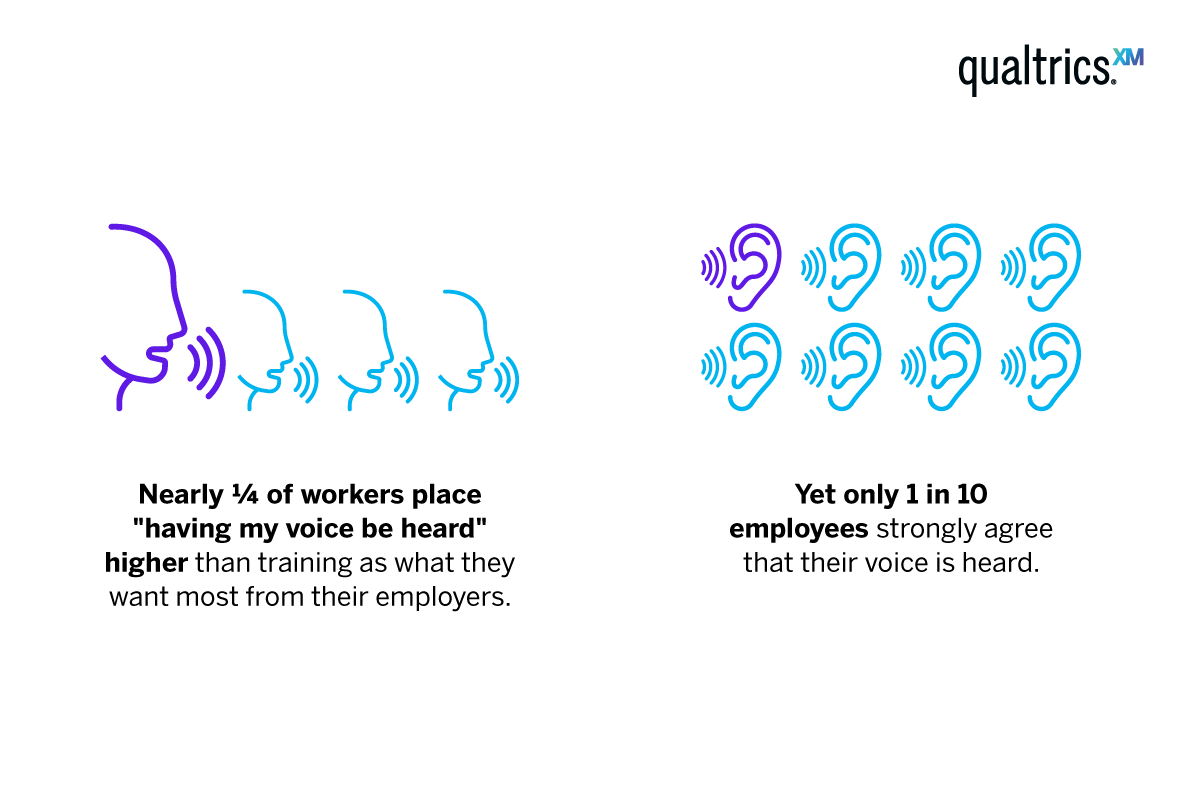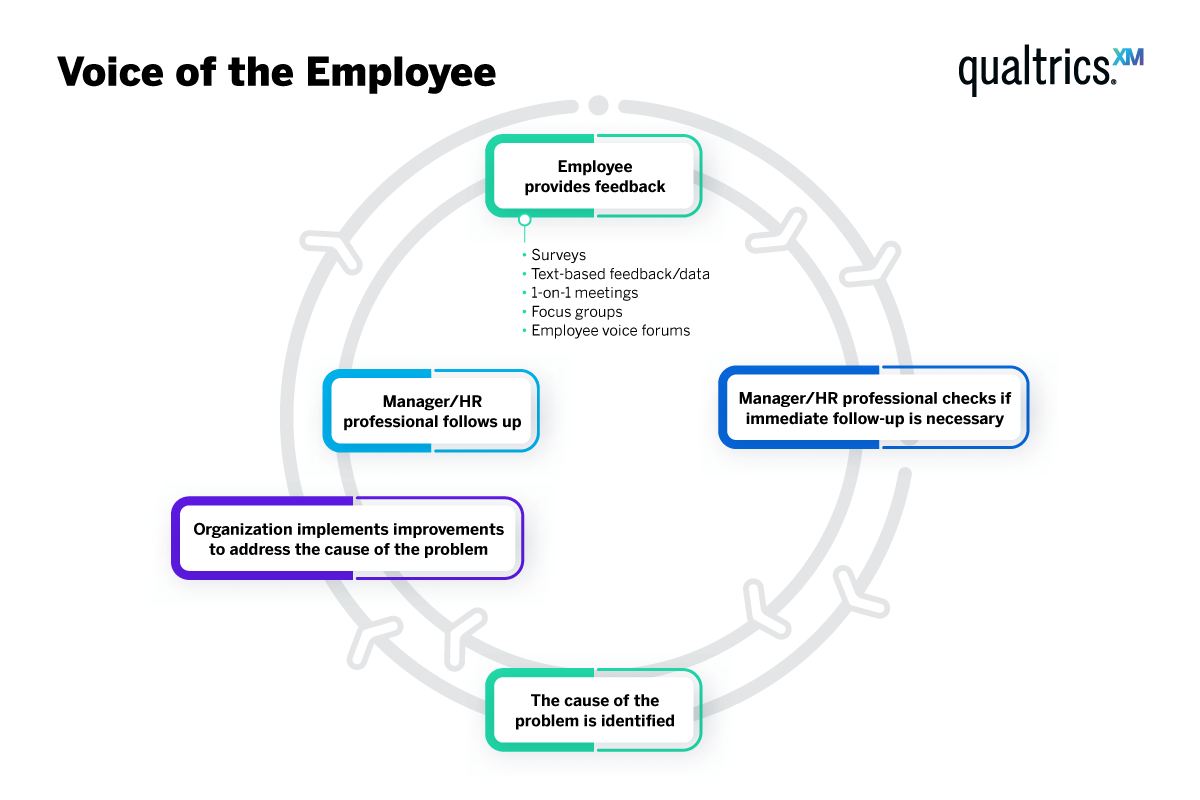What is the voice of the employee?
At the heart of the voice of the employee is employee feedback – what your employees tell you about all aspects of their jobs. Voice of the employee initiatives can be formal and informal.
- Formal: organized employee surveys (pulse surveys, engagement surveys, 360 surveys, one on one surveys, exit surveys), polls, performance reviews, focus groups, consultation groups
- Informal: team chats, one on one conversations, collaboration tools such as Slack, business intranets, always-on feedback platforms, company discussions
According to research by Howspace, employees want to be heard at work, but many don’t feel they are:
- Nearly 25% of workers place ‘having my voice heard’ above training as something they want most from employers
- Only 10% of employees ‘strongly agree’ that their voice is heard

Why is the voice of the employee critical for business?
When you consider that a business’s most important asset is its employees, their perspective is the one you must take the most seriously. Listening to every employee voice will give you real-time insights into your business and customers that you cannot get from balance sheets or the profit and loss account.
Request Demo: Ensure your employees are always heard
What is the return on investment (ROI) of a voice of the employee program?
While it’s difficult to quantify the ROI of a voice of the employee program in terms of hard revenue, when you see it in the context of employee experience and employee engagement it begins to make sense. Employees who are listened to and see tangible actions taken are more engaged, and enjoy a more positive employee experience.
Glassdoor research shows that there’s a clear correlation between employee experience and customer satisfaction. On average, a 1-point increase in Glassdoor company rating is associated with a 1.3 increase in customer satisfaction.
And a recent Gallup report shows that companies with high employee engagement have 21% higher profitability. They also have 17% higher productivity than companies with a disengaged workforce.
What are the benefits of the voice of the employee?
More employee satisfaction
Voice of the employee can increase employee satisfaction because issues and concerns can be flagged up early and resolved. This helps employees feel that they’ve been empowered to do a good job, backed by a support network that cares what they think and say.
Greater customer satisfaction
According to Josh Bersin, employee experience and customer experience are ‘two sides of the same coin’. If you have unhappy, disgruntled employees, it follows that your customers will be unhappy and disgruntled too.
Employees who are listened to, and have their feedback taken on board and acted upon are more likely to have job satisfaction when they face customers. When employees feel valued like this, they are 8.5x more likely to satisfy and retain customers.
Higher employee retention
With a high employee satisfaction rating comes more employee retention. When people are happy in their work they tend to stay longer. When employees are listened to, and their feedback acted upon, this is indicative of healthy communication practices between leaders, managers and teams.
Feedback isn’t a one-way street from managers to employees. The voice of the employee encourages upward feedback to management. When employees are uncomfortable giving upward feedback, they are 16% less likely to stay. When everyone feels safe and encouraged to give feedback, employees stay longer.
Improved employee engagement
Employee voice has for many years been one of the four enablers of employee engagement. When employees know that what they say is going to be heard and actioned, they become more engaged with their work. And as improvements are made as a result of employee feedback, engagement increases even more.
Research by Gallup found that engaged employees deliver some great business outcomes, which include:
- 10% higher customer ratings
- 17% higher productivity
- 20% higher sales
- 21% higher profitability
Businesses that truly hear their employees are 12x more likely to engage and retain them.
More employee feedback
‘Feedback is a gift’, so the saying goes, as it leads to improvement. And like a gift, it needs to be treasured. An annual engagement survey is no longer enough to understand what your workforce is feeling and thinking. Regular surveys give you more feedback, although there is the danger of survey fatigue where employees get bored of answering questions and may disengage.
And listening to the voice of the employee just got even more sophisticated with platforms that combine omni-channel listening, natural language processing, AI-powered automation and intelligent alerts. Now, you don’t have to ask for employee feedback – you can listen for it.
A great company culture
When employees listen to each other, everybody gets to know each other better. And when people know each other, there’s less room for conflict. Issues and tensions can be ‘nipped in the bud’ when people feel safe to speak their minds, and people will share ideas and feel free to highlight pain points and areas for improvement.
And of course the gold standard of organizational culture is one of belonging. Businesses that listen to their employees, collect feedback, and take action are 8.4x more likely to inspire that sense of belonging.
More innovation
Organizations that listen to their employees and then act on their feedback are 3.6x more likely to innovate well. A business is always greater than the sum of its parts IF you give all your employees a say with an employee voice program. By analyzing employee feedback from all your workforce, you’ll get a diverse perspective on problems and issues, and more innovative and effective solutions suggested.
Voice of the employee programs – best practices
There’s a 4-step process you need to follow when creating your voice of the employee program:
1. Collect VoE data
It’s great to have one-on-one meetings with employees, and good managers will do this with each team member on a regular basis. These one on ones are a good place to start to collect VoE data, particularly when you use an employee survey at the end of it, and to inform the next meeting. However, don’t expect employees to be as candid as they will be in an anonymous survey.
Which should be your next port of call in your VoE program. Use:
- Customizable online surveys with a mixture of closed responses:
- True or false
- Yes/No
- A Likert scale with survey responses on a scale from 1 to 10
Text-based employee feedback in open text boxes that lets people answer in more detail and in their own words.
You will gather quantitative data from the closed responses, and more detailed qualitative data from the open text responses.
You can also use employee listening tools such as Discover XM on multiple channels to understand what people are saying about your company, wherever they’re saying it. From the contact center to social media posts to online reviews — and many other channels in between.

2. Analyze your VoE data
Once you’ve gathered your data, you need to turn it into insights. Gone are the days of manual analysis, spreadsheets and crunching numbers with Excel.
SaaS platforms use employee sentiment analysis tools, artificial intelligence (AI) and natural language processing to analyze all your unstructured, open-ended, qualitative VoE data automatically. This systematic process produces detailed and much more nuanced VoE analysis.
These platforms know the difference in the subtleties of human language — including emojis, to uncover the emotion, intent, and effort of each interaction. They show, in an easy-to-read format, the drivers of experience, how important they are, and how employees rated them.
3. Act on your data
There’s no point gathering feedback if you’re not going to do anything with it. Once the cause of an issue is identified, the business needs to address it and make improvements. You then ‘close the feedback loop’ by showing employees what you have done as a result of their honest feedback.
4. Measure the impact
You’ve made the improvements, now you need to know if they have solved the problem in the way that you, and your employees hoped it would. A good VoE program will include questions on the improvement so that you can measure its impact.
Dos and don’ts for your own VoE program
Do:
- Be clear on the issue that you want feedback on
- Use a VoE tool that works for your whole organization
- Create a workplace culture of belonging where everyone feels safe voicing their opinion
- Ask everyone in the organization, for a diverse perspective
- Make VoE programs fun – maybe with gamification
- Use anonymous feedback
- Segment and analyze VoE data holistically
- Ask questions that you don’t know the answer to – somebody will
- Close the feedback loop by showing employees the actions you will take
- Act!
Don’t:
- Run only an annual employee engagement survey
- Just use surveys – there are plenty of other VoE tools available
- Create boring surveys that lead to survey fatigue
- Fail to act on feedback
- Use a jumble of stats – tell a story with your data
- Analyze VoE data in silos
It takes some effort to set up a voice of the employee program in your organization. But with the right approach and tools you’ll gain actionable insights into your employees’ wants and needs, identify issues, resolve problems before they grow out of control, and nurture a workplace culture where everyone feels safe, included, engaged and productive.
We think that’s well worth the effort.
Ensure your employees are always heard


